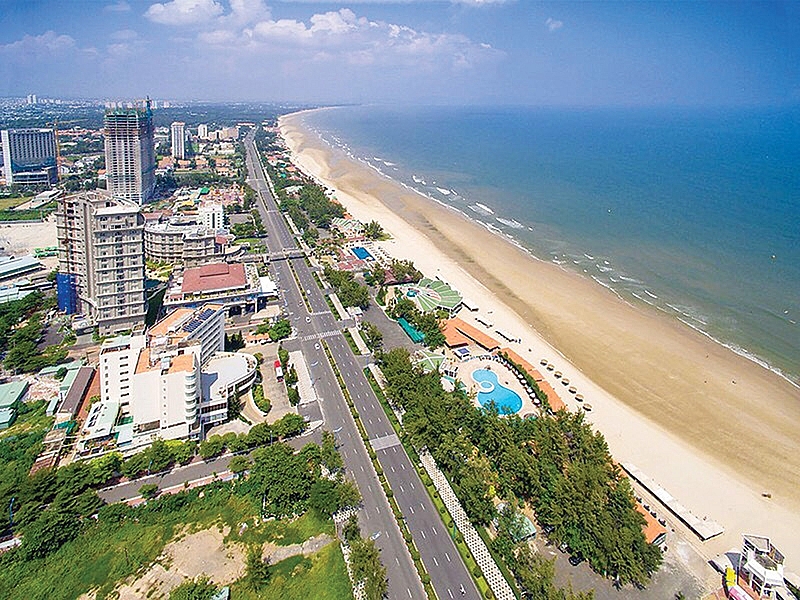Ba Ria-Vung Tau clearing away bottlenecks to prompt growth
 |
| Infrastructure improvements are among top priority areas |
One of the crucial factors to propel socio-economic development and court investment in the province pertains to administrative procedure reforms. With that in mind, the provincial People’s Committee recently enacted Document No.4213/UBND-SNV on implementing several major tasks to push up such reforms across Ba Ria-Vung Tau.
Accordingly, the leaders of authorised management agencies were urged to focus on perfecting the regulatory system to ensure quality, being consistent with the application of a one-stop shop mechanism in dealing with administrative procedures, and ensuring a proper service attitude when working with local people and businesses.
From last December, under guidance from provincial leaders, all one-stop shop sections from communal to district level began to apply ‘no glass separation’ model between on-duty state employees and residents to increase goodwill with people visiting to settle administrative procedures.
In order to boost operational efficiency, the province is accelerating efforts to soon establish a specific public administrative centre, which will be based on the one-stop shop division. Its core functions will be receiving and evaluating proposals, along with dealing with and delivering results to both people and businesses. The centre is expected to be set up in the next few months, and is one highlight in the provincial management’s agenda this year. The province is also working on a plan to establish the public administrative centre. To ensure the centre’s effective operation after establishment, a plan on building a specialised portal of province-based public services is being considered, striving to maximise comfort for local people and organisations when handling procedures.
In a recent working session involving Prime Minister Nguyen Xuan Phuc and Ho Chi Minh City and provinces in the key southern economic zone, Nguyen Van Trinh, Chairman of the Ba Ria-Vung Tau People’s Committee, reported on an overload situation at National Highway 51. The overload has significantly lengthened travel time from key localities in the southern key economic zone to the province, as well as stalled trade exchange and passenger transport. Building an expressway connecting Ba Ria-Vung Tau and other localities in the region, therefore, proves an urgent matter.
As a result, Trinh proposed to the prime minister and the Ministry of Transport to give in-principle approval and assign the province to implement a project on building Bien Hoa-Vung Tau Expressway under a build-operate-transfer format.
Besides the expressway, the provincial leader also sought government approval for the feasibility study report of the Phuoc An Bridge project, as well as aiding part of the capital for the project’s implementation.
This is an important component for building up a comprehensive road-to-port system connecting Ba Ria-Vung Tau to Dong Nai and Ho Chi Minh City, effectively serving the port systems in the province and in Dong Nai.
In addition, efforts will be geared towards accelerating investment pace at Ring Road 4 connecting Ho Chi Minh City and the southern provinces of Binh Duong, Dong Nai, Ba Ria-Vung Tau, and Long An, as well as an associated railway to reduce costs and times for freight transport.
In light of Ba Ria-Vung Tau’s development orientation, the province is to vie for effective exploitation of the local seaport system and related services. Of this, the Cai Mep-Thi Vai port complex will act as a gateway and transit port of international significance, and port logistics services will grow into becoming the province’s spearhead economic sector.
According to the Ba Ria-Vung Tau People’s Committee, the province’s gross regional domestic product (GRDP) grew 5.7 per cent per year during 2011-2018 and is expected to pick up 7.5 per cent this year. The province’s GRDP hopes to reach VND125 trillion ($5.43 billion) by 2020, up 1.6 times against 2011 and 1.2 times against 2016.
What the stars mean:
★ Poor ★ ★ Promising ★★★ Good ★★★★ Very good ★★★★★ Exceptional
 Tag:
Tag:
Related Contents
Latest News
More News
- Global partnerships key to Vietnam’s IFC development (December 26, 2025 | 16:18)
- Vingroup pulls out of bid to invest in North-South high-speed railway (December 26, 2025 | 11:42)
- Strengthening supply chains through trade promotions and customs reform (December 24, 2025 | 14:00)
- PM orders investment model for North–South high-speed rail (December 22, 2025 | 17:43)
- LS Eco Energy to invest in Vietnam rare earth sector (December 22, 2025 | 17:31)
- Government moves to establish International Financial Centre (December 21, 2025 | 21:00)
- Vietnam's IFC to target global investment flows (December 21, 2025 | 18:00)
- Two national hospitals expand capacity with new facilities (December 20, 2025 | 09:00)
- Ha Tinh breaks ground on major Vingroup industrial and energy projects (December 19, 2025 | 18:24)
- EVN launches major power infrastructure projects nationwide (December 19, 2025 | 18:17)























 Mobile Version
Mobile Version